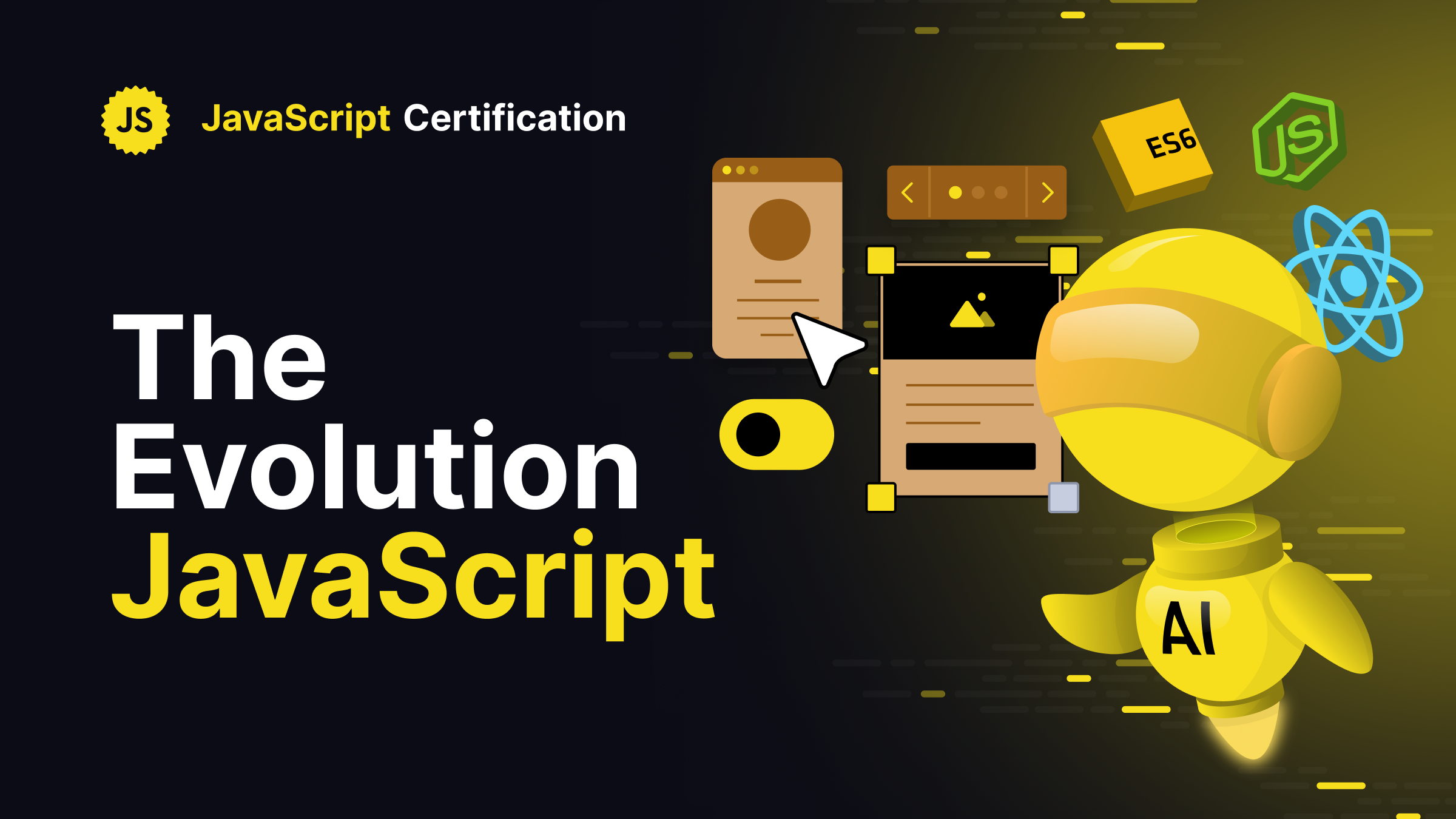
The Evolution of JavaScript: From Simple Scripting to AI and Beyond
Journey through JavaScript's evolution, from basic scripting to powering complex web apps and AI. Discover how this versatile language has transformed web development, expanded to server-side programming, and continues to shape the future of technology.
Daniel Kelly
August 22, 2024
Remember when JavaScript was just for making annoying pop-ups and flashy mouse-over effects? Those days are long gone. Today, JavaScript powers everything from complex web applications to machine learning models. Let's embark on a journey through the evolution of this versatile language, from its humble beginnings to its current status as the Swiss Army knife of programming.
The Early Days: Basic DOM Manipulation
Back in 1995, Brendan Eich created JavaScript in just 10 days (talk about a tight deadline!). Its initial mission was simple: make websites less static. In those early days, you might have used JavaScript to validate a form or create a dynamic drop-down menu.
// JavaScript circa 1995
function validateForm() {
var name = document.forms["myForm"]["name"].value;
if (name == "") {
alert("Name must be filled out");
return false;
}
}
This was exciting stuff for the time, but it was just the beginning.
The Rise of AJAX and jQuery
As the web grew more complex, so did our needs. Enter AJAX and jQuery, two game-changers that expanded JavaScript's capabilities and made developers' lives easier.
AJAX allowed us to update parts of a web page without reloading the entire thing. Suddenly, web applications could be fast, dynamic, and responsive. Furthermore jQuery, gave us a unified API to work with the DOM across different browsers.
// jQuery magic circa 2006
$.ajax({
url: "api/data",
success: function(result) {
$("#data-container").html(result);
}
});
The ES6 Revolution and Beyond
Then came ES6 (ECMAScript 2015), and JavaScript developers everywhere breathed a collective sigh of relief. ES6 introduced a slew of features that made JavaScript more powerful and easier to write: arrow functions, let/const, template literals, promises, and modules, to name a few.
// ES6 goodness
const fetchData = async () => {
try {
const response = await fetch('api/data');
const data = await response.json();
console.log(`Received data: ${JSON.stringify(data)}`);
} catch (error) {
console.error('Failed to fetch data:', error);
}
};
These features solved real-world problems. Promises and async/await, for instance, made handling asynchronous operations much more intuitive, freeing us from the dreaded "callback hell."
The introduction of transpilers like Babel and polyfills allowed developers to use these new features while maintaining compatibility with older browsers, accelerating the adoption of modern JavaScript.
Node.js: JavaScript Beyond the Browser
Just when we thought JavaScript was content with conquering the frontend, along came Node.js, taking our beloved language server-side. This wasn't just a small step for JavaScript—it was a giant leap for web development.
Node.js allowed developers to use JavaScript for server-side programming, opening up a world of possibilities. Full-stack JavaScript became a reality, enabling developers to use the same language across the entire stack.
// Simple Node.js server
const express = require('express');
const app = express();
const port = 3000;
app.get('/', (req, res) => {
res.send('Hello, Node.js!');
});
app.listen(port, () => {
console.log(`Server running at http://localhost:${port}`);
});
Frameworks like Express.js further extended Node.js capabilities, making it easier to build robust, scalable web applications. The ability to share code between frontend and backend, along with Node.js's event-driven, non-blocking I/O model, made it a go-to choice for building high-performance, real-time applications.
The Age of Modern Frameworks
Enter React, Vue, and Angular. Building complex user interfaces became less about wrangling DOM elements and more about composing reusable components. These frameworks brought structure and efficiency to frontend development, making it easier to build and maintain large-scale applications.
<script setup>
import { ref } from 'vue'
const count = ref(0)
</script>
<template>
<div id="app">
<button @click="count++">
Count is: {{ count }}
</button>
</div>
</template>
Each framework has it’s stengths and weakness but they’ve all evolved similar solutions to common problems. Each is a good choice for building scalable and maintainable web applications.
JavaScript Today: The Swiss Army Knife of Programming
Today, JavaScript is everywhere. It powers web applications, mobile apps (thanks to frameworks like React Native), desktop applications (hello, Electron!), and even Internet of Things devices. Want to build a web server? JavaScript's got you covered. Need to interact with a database? JavaScript can do that too. Looking to dive into machine learning? Yep, JavaScript can handle that as well.
The Future of JavaScript: AI, ML, and Beyond
As we look to the future, JavaScript's journey is far from over. It's making significant inroads into cutting-edge fields like artificial intelligence and machine learning. Libraries like TensorFlow.js are bringing machine learning capabilities directly to the browser and Node.js.
// Simple machine learning with TensorFlow.js
import * as tf from '@tensorflow/tfjs';
// Create a simple model
const model = tf.sequential();
model.add(tf.layers.dense({units: 1, inputShape: [1]}));
// Prepare the model for training
model.compile({loss: 'meanSquaredError', optimizer: 'sgd'});
// Generate some synthetic data for training
const xs = tf.tensor2d([-1, 0, 1, 2, 3, 4], [6, 1]);
const ys = tf.tensor2d([-3, -1, 1, 3, 5, 7], [6, 1]);
// Train the model
model.fit(xs, ys, {epochs: 250}).then(() => {
// Use the model to do inference on a data point
model.predict(tf.tensor2d([10], [1, 1])).print();
});
JavaScript is also playing a crucial role in serverless architectures, enabling developers to build and deploy scalable applications without managing the underlying infrastructure.
The Importance of Keeping Pace
From its humble beginnings to its current status as a versatile, powerful language, JavaScript has come a long way. Its evolution reflects the changing landscape of web development and technology as a whole.
As JavaScript continues to evolve, staying current with its latest features and best practices is more crucial than ever. Whether you're building a simple website or a complex AI-powered application, JavaScript likely plays a vital role in your toolkit. If you're interested in validating your skills and joining a community of certified JavaScript developers, you can sign up at Certificates.dev for updates about our JavaScript Certification program launching on September 24th. This certification offers an opportunity to showcase your expertise and potentially open new doors in your career.
More certificates.dev articles
Get the latest news and updates on developer certifications. Content is updated regularly, so please make sure to bookmark this page or sign up to get the latest content directly in your inbox.

How to animate transitions with Angular?
Angular 20.2 introduces a delightfully simple way to animate elements as they enter and leave the screen. With zero imports and CSS doing all the heavy lifting, the new animate.enter and animate.leave attributes let you add smooth, modern transitions with minimal code and maximum sanity.
Alain Chautard
Dec 26, 2025

Starting a React Project? shadcn/ui, Radix, and Base UI Explained
Understand unstyled component libraries, compare Radix and Base UI, and learn how shadcn/ui and shadcn/create help you build React apps your way.
Aurora Scharff
Dec 24, 2025

Understanding try...catch in JavaScript: How to Handle Errors Properly
Learn how JavaScript errors work and how to prevent your app from crashing using try...catch. Includes simple examples, async caveats, custom errors, JSON parsing, and best practices for writing robust, user-friendly code.
Martin Ferret
Dec 21, 2025
Looking for Certified Developers?
We can help you recruit Certified Developers for your organization or project. The team has helped many customers employ suitable resources from a pool of 100s of qualified Developers.
Let us help you get the resources you need.

(a Cisco company)